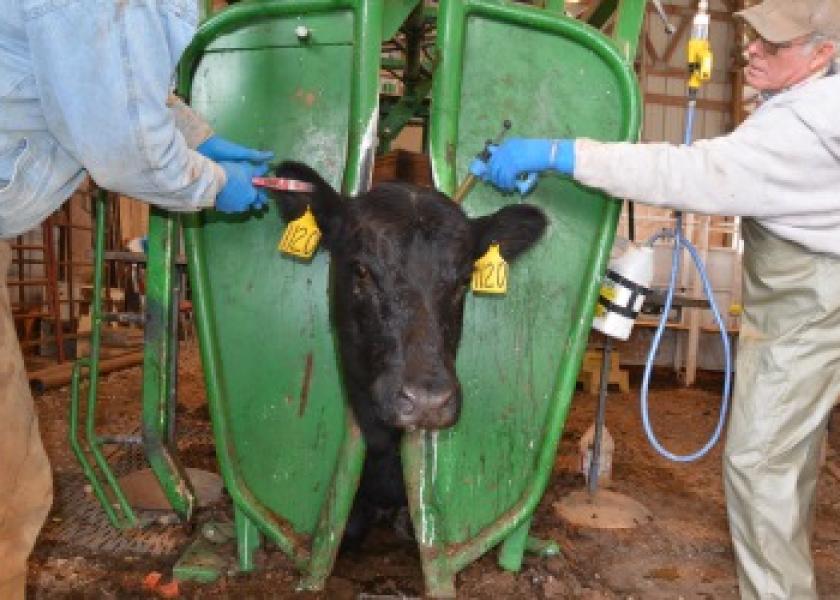Avoid Loss from Purchased Disease; Isolate and Test to Protect the Cow Herd

Many diseases that occur in the cow-herd are purchased--meaning many diseases enter the herd through purchased cows, heifers, and bulls.
By: Gregg Hanzlicek, DVM, production animal field investigations director, Kansas State University
Without exception, keeping diseases out of the cow-herd is much easier than attempting to eliminate the diseases once they are present. The term for herd health programs designed to keep disease out of a herd is called “biosecurity”.
There are several diseases that cow-calf producers should concentrate on when designing a biosecurity program. Some examples include Johne’s, Anaplasmosis, Salmonellosis, Bovine viral diarrhea (BVD), and Trichomoniasis. Although all of these diseases are important, two are extremely important: BVD and Trichomoniasis.
Bovine viral diarrhea is a disease that can have a huge negative impact on the breeding success of the cow-herd. The presence of BVD can manifest itself through reduced fertility, increased early embryonic death, and abortions. It is spread through contact with several body fluids including saliva, uterine, and respiratory secretions. Additionally, close nose to nose contact can also pass the virus from one animal to another.
The animal which provides the largest potential for spreading this disease is the persistently infected calf. We call these animals PI’s. These are calves that were exposed to the BVD virus during the first four months of gestation. The calf’s dam is exposed to the virus and passes it to the calf through the placenta. The calf, at this stage of gestation, cannot recognize the virus as being foreign so it allows the virus to enter all its cells to live and reproduce. Some calves exposed to BVD during gestation will be lost before birth, but a percentage will be born alive, and most will appear to be normal. Although they may look normal, these PI calves are walking BVD virus transmitters, and they never stop transmitting the virus; therefore, reducing performance and/or fertility of any herdmates they contact.
To prevent BVD from entering the herd, several measures must be taken. One, all animals (bulls, cows, heifers, calves) which come from outside sources must be tested to be PI negative before entry into the herd. Two, all animals from outside sources must be isolated for 30-45 days before exposure to the rest of the herd. (Isolating animals returning from shows is also a good policy.) Although PI’s pose the biggest threat to BVD entry, some infected animals will be short term BVD carriers. Isolation from the herd will allow these short-term carriers to clear the BVD infection thus no longer posing a threat. Three, all calves born to cows or heifers from outside sources that are already pregnant upon arrival must be PI tested at birth. It is dangerous to test the dams, and conclude if they are negative so too will be their calves. Most PI calves are born to non-PI dams! Four, assure the herd is on a well-designed BVD vaccination program. No vaccine can prevent all disease, but providing a proper vaccination program will help reduce the risk of BVD infection in the herd should exposure occur.
Another disease to guard against is Trichomoniasis or Trich. This is a disease which can only be spread during the breeding act. A herd infected with Trich usually has a large percentage of open cows. Some herds can experience a 60% or greater open cow rate when Trich is present.
Bulls are the primary carriers of Trich, and they are considered to be carriers for life. Although older bulls are more likely to be lifelong carriers, bulls of all ages can carry Trich organisms. More than one yearling bull has been found to be Trich positive. Open cows, and cows less than 120 days pregnant are also potential Trich carriers.
One of the biggest risks for purchasing Trich is buying, leasing, or borrowing used cows or bulls. Using them can be part of a successful program, but these practices present a huge risk for bringing Trich into the herd for the reasons mentioned above.
To reduce the risk of introducing Trich into your herd, buying virgin bulls is the best practice. Because
this disease can only be contracted through the breeding act, virgin bulls will not be Trich carriers.
If bulls of unknown reproductive experience are to be brought into the herd, each bull needs to be Trich tested before entry. If these bulls are from herds with no history of Trich, one negative test is appropriate. If they are from operations of unknown Trich history, then at least two negative tests need to be completed before entry. Sampling open cows is not routinely practiced because of the cost and that the test was designed to be used on bull samples.
Another Trich risk factor is pasturing next to an infected herd or herd which practices high risk behaviors
such as purchasing used cows and bulls. No fence can keep all cows and bulls from getting into
neighboring pastures. It is not always practical to pasture away from neighbors, but any mixing of the
herds can potentially spread Trich into your herd.
Trichomoniasis vaccines are not usually a component of a Trich biosecurity program because the
vaccines are not very effective. These vaccines do not prevent infection but may slightly reduce the
percentage of lost pregnancies. It is therefore much more important to base a Trich biosecurity program
on allowing only animals that are at a very low risk of being carriers to enter the herd.
Fortunately, many of the important diseases which occur on the cow-calf operation are purchased diseases.
This means many times the disease can be prevented from entering the herd through effective biosecurity programs. An effective biosecurity program designed to minimize the introduction of these diseases into your herd is well worth the time, effort, and monetary investment. Your local veterinarian is the best resource to help customize a program for your operation. Remember, disease prevention is much easier than disease elimination.







